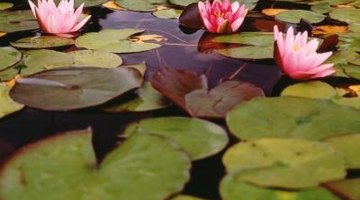What Size Pond Filter for a 300-Gallon Pond?
When choosing a pond filter for your pond, there are a number of mitigating factors. Many aquatic plants do a fair amount of water filtering naturally, however some frequently drop foliage which can add to the organic matter in your water. Fish eat algae, but fish excrement can contaminate pond water. Determining a pond filter for your 300-gallon pond means examining a few factors.
Location

If your 300-gallon pond is located in direct sunlight, you will need a larger filter to keep algae at bay. Algae is a photosynthetic organism, which means it needs sunlight to survive. Shaded ponds will have less algae and therefore will require a smaller filter. If your pond is in direct sunlight, verify that your pond filter is attached to a pump that pumps at least 300 gallons per hour, meaning you want all of your pond water cycling through your filter at least once an hour. If your pond is shaded through the hot afternoon hours, this number can be reduced to 250.
Aquatic Plants
A pond with more plants, generally, requires less filtration. If you cover at least 3/4 of the surface of your pond with floating aquatic plants, you can reduce your pond filter gallons per hour requirement. Aquatic plants work not only to absorb dissolved nutrients in the water but also shade the water, thereby reducing algae growth. Add aquatic plants, and you can keep your water clean with a 200-gallon per hour pump attached to your filter.
Fish
The presence of fish is a complicating factor as far as pond pumps and filters are concerned. Fish do eat some algae, and some species, such as goldfish, will eat a considerable amount of it. They also add waste to the water in the form of excrement, however, and have a higher water quality requirement than aquatic plants. Additionally, fish need dissolved oxygen in the water to survive, which is replenished by your pond spout or waterfall. Therefore, if your pond has fish, you need to have your filter attached to a pond pump that pumps at least the volume of the pond per hour, which in this case is 300 gallons per hour.
Experiment
If your pond does not have fish, feel free to experiment with adding more aquatic plants and reducing your pumping power. You can save electricity and get a good handle on how well some naturally filtering plants, such as Water Hyacinths, work. Many varieties of pond filters exist, such as biological filters, that work with nature to keep your pond water clean and therefore require considerably less maintenance and upkeep. In a pond without fish to worry about, you can tweak and adjust your pond pumps, filters and plants until you get the crystal clear water you desire.
References
Writer Bio
Andrew Leahey has been a writer since 1999, covering topics as varied as technology how-to guides and the politics of genetically modified organisms to African food supplies. He is pursuing his J.D. while renovating an 1887 farmhouse located in the New Jersey Pine Barrens.
Photo Credits
- Stockbyte/Stockbyte/Getty Images
More Articles



